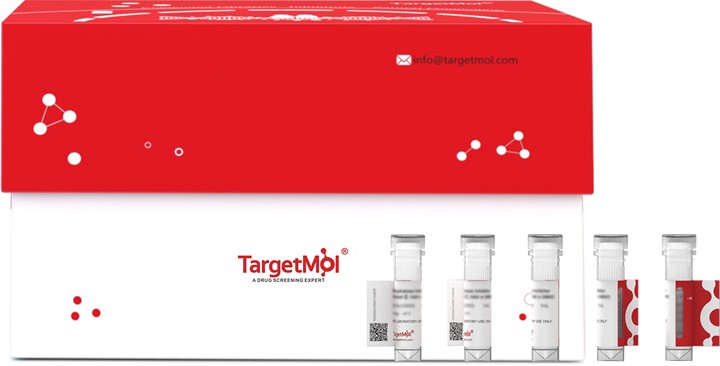 Your shopping cart is currently empty
Your shopping cart is currently empty
HGFR/c-Met Protein, Human, Recombinant (aa 25-932, His & Avi), Biotinylated
Hepatocyte growth factor receptor (HGF R) is a glycosylated receptor tyrosine kinase that plays a central role in epithelial morphogenesis and cancer development. HGF R is synthesized as a single chain precursor which undergoes cotranslational proteolytic cleavage. Mature HGF R is a disulfide-linked dimer composed of a 50 kDa extracellular α chain and a 145 kDa transmembrane β chain. Proteolysis and alternate splicing generate additional forms of human HGF R which either lack of the kinase domain, consist of secreted extracellular domains, or are deficient in proteolytic separation of the α and β chains. The sema domain, which is formed by both α and β chains of HGF R, mediates both ligand binding and receptor dimerization. HGF stimulation induces HGF R downregulation via internalization and proteasomedependent degradation. Paracrine induction of epithelial cell scattering and branching tubulogenesis results from the stimulation of HGF R on undifferentiated epithelium by HGF released from neighboring mesenchymal cells.

HGFR/c-Met Protein, Human, Recombinant (aa 25-932, His & Avi), Biotinylated
| Pack Size | Price | USA Warehouse | Global Warehouse | Quantity |
|---|---|---|---|---|
| 5 μg | $129 | 7-10 days | 7-10 days | |
| 10 μg | $213 | 7-10 days | 7-10 days | |
| 20 μg | $355 | 7-10 days | 7-10 days | |
| 50 μg | $625 | 7-10 days | 7-10 days | |
| 100 μg | $963 | 7-10 days | 7-10 days |
Product Information
| Biological Activity | Activity has not been tested. It is theoretically active, but we cannot guarantee it. If you require protein activity, we recommend choosing the eukaryotic expression version first. |
| Description | Hepatocyte growth factor receptor (HGF R) is a glycosylated receptor tyrosine kinase that plays a central role in epithelial morphogenesis and cancer development. HGF R is synthesized as a single chain precursor which undergoes cotranslational proteolytic cleavage. Mature HGF R is a disulfide-linked dimer composed of a 50 kDa extracellular α chain and a 145 kDa transmembrane β chain. Proteolysis and alternate splicing generate additional forms of human HGF R which either lack of the kinase domain, consist of secreted extracellular domains, or are deficient in proteolytic separation of the α and β chains. The sema domain, which is formed by both α and β chains of HGF R, mediates both ligand binding and receptor dimerization. HGF stimulation induces HGF R downregulation via internalization and proteasomedependent degradation. Paracrine induction of epithelial cell scattering and branching tubulogenesis results from the stimulation of HGF R on undifferentiated epithelium by HGF released from neighboring mesenchymal cells. |
| Species | Human |
| Expression System | HEK293 Cells |
| Tag | C-6xHis-Avi |
| Accession Number | P08581 |
| Synonyms | Tyrosine-protein kinase Met,SF receptor,Scatter factor receptor,Proto-oncogene c-Met,MET,HGF/SF receptor,HGF receptor,Hepatocyte growth factor receptor |
| Amino Acid | Glu25-Thr932 |
| Construction | Glu25-Thr932 |
| Protein Purity | Greater than 95% as determined by reducing SDS-PAGE. (QC verified) |
| Molecular Weight | 75-95&40-50 KDa (reducing condition) |
| Endotoxin | < 0.1 ng/µg (1 EU/µg) as determined by LAL test. |
| Formulation | Lyophilized from a solution filtered through a 0.22 μm filter, containing PBS, pH 7.4. |
| Reconstitution | Reconstitute the lyophilized protein in distilled water. The product concentration should not be less than 100 μg/ml. Before opening, centrifuge the tube to collect powder at the bottom. After adding the reconstitution buffer, avoid vortexing or pipetting for mixing. |
| Stability & Storage | Lyophilized powders can be stably stored for over 12 months, while liquid products can be stored for 6-12 months at -80°C. For reconstituted protein solutions, the solution can be stored at -20°C to -80°C for at least 3 months. Please avoid multiple freeze-thaw cycles and store products in aliquots. |
| Shipping | In general, Lyophilized powders are shipping with blue ice. Solutions are shipping with dry ice. |
| Research Background | Hepatocyte growth factor receptor (HGF R) is a glycosylated receptor tyrosine kinase that plays a central role in epithelial morphogenesis and cancer development. HGF R is synthesized as a single chain precursor which undergoes cotranslational proteolytic cleavage. Mature HGF R is a disulfide-linked dimer composed of a 50 kDa extracellular α chain and a 145 kDa transmembrane β chain. Proteolysis and alternate splicing generate additional forms of human HGF R which either lack of the kinase domain, consist of secreted extracellular domains, or are deficient in proteolytic separation of the α and β chains. The sema domain, which is formed by both α and β chains of HGF R, mediates both ligand binding and receptor dimerization. HGF stimulation induces HGF R downregulation via internalization and proteasomedependent degradation. Paracrine induction of epithelial cell scattering and branching tubulogenesis results from the stimulation of HGF R on undifferentiated epithelium by HGF released from neighboring mesenchymal cells. |
Dose Conversion
Calculator
Tech Support
| Size | Quantity | Unit Price | Amount | Operation |
|---|

Copyright © 2015-2025 TargetMol Chemicals Inc. All Rights Reserved.



